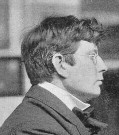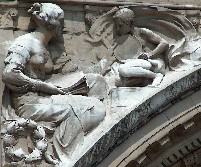 Frampton in 1902.
Frampton in 1902.
The symbolist sculptor George Frampton was born in London, and after working in an architect's office, was apprenticed to an architectural stone carver. He then attended the modelling class at South London Technical Art School under the teacher and architectural sculptor W. S. Frith, and in 1881 entered the Royal Academy Schools. He won a travelling scholarship and in 1887 went to Paris, to study under Mercie and Dagnan-Bouveret. He returned to London in 1889, and took a position teaching sculpture at the Slade in 1893. He was elected ARA in the following year, and became a full Academician in 1902, and in 1911-12 serving as President of the Royal Society of British Sculptors.
Frampton's range was wide. He showed symbolist-style ideal figures and busts early on, owing something to Alfred Gilbert and something to later Pre-Raphaelitism as espoused by Burne-Jones. In these works, he favoured the use of mixed materials and colour, again as espoused by Alfred Gilbert. He was active in the Arts and Crafts movement, exhibiting with the Arts and Crafts Exhibition Society from 1893, and making a wide range of decorative work - jewellery, enamelling, medals and decoration for the house, and developng a type of plaster relief which he had evolved with Anning Bell (with whom he had shared a studio). In his sculpture at this time, Frampton often favoured girls with an Arts and Crafts look, with short hair, often constrained under triangular napkin-like coverings, making his ideal rather Dutch in look, also very youthful in face and figure.
Frampton produced many portrait busts and memorial statues, and these latter often incorporated small, inventive arts and crafts figures. As befitted his training, he devoted much effort to architectural sculpture, most spectacularly for the Lloyds Registry building in Fenchurch Street. Frampton's wife, Christabel, was a painter.
Examples of Frampton's symbolist ideal sculptures are Lamia (1900) in a plaster version in Birmingham, and Mysteriarch (1892) in Liverpool, both sometimes shown in Symbolist and Art Nouveau exhibitions. His portrait statues include the Queen Victoria monument in Leeds (now on Woodhouse Moor), Dame Alice Owen in Potters Bar, three statues, including Rathbone, in St John's Gardens, Liverpool, the 3rd Marquess of Salisbury in Hatfield, and in London, the W. S Gilbert monument and Walter Besant on the Embankment, Quintin Hogg in Portland Place and his very late (1920) Edith Cavell in St Martins Place. And in Kensington Gardens, rather defying classification, is his Peter Pan Monument. Among his architectural works in London are the spandrel figures over the entrance to the Victoria and Albert Museum, spandrel reliefs for Electra House, Moorgate (now owned by a University), and the bronze figures and stone carvings for the aforementioned Lloyds Registry in Fenchurch Street. Outside London, we must also mention the figures he made for Glasgow City Art Gallery. Examples of portrait busts are at Peterborough. A rather good Boer War Memorial is at Salford - shown on this page.
Frampton stands out as one of the most important of the New Sculptors, and the accessibility of his work in museums and architectural sculpture across the country makes it easy to acquire a familiarity with his works.
 Typical spandrel figure by Frampton.
Typical spandrel figure by Frampton.
Visitors to this page since 22 Nov 2011: 9,879